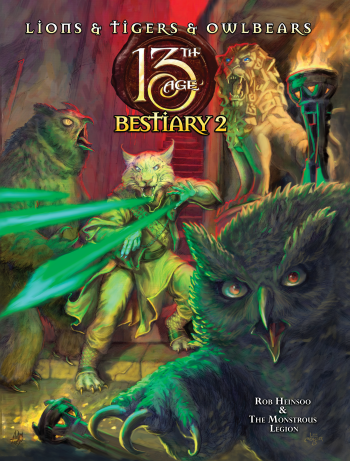
Igor Coura asked a question on
Twitter that’s better answered in prose. Igor is in the middle of converting
some monsters from other F20 games to 13th Age, and found
himself wondering why we use the category of large monsters to mean “twice as
powerful as a normal monster.” Other F20 games tend not to do it that way, when
they want a more powerful monster they just use a higher level creature.
13th Age
monster levels determine the important stats that shape every combat: attack
bonus, defenses, and hit points. We created the extra-knob for double-strength
(and even triple-strength) monsters because we wanted certain monsters to
survive longer in a fight, to have more weight as something that the PCs have
to take seriously. If you add a couple levels to a monster, it certainly has to
be taken more seriously, but as monsters (and PCs) gain +1 attack &
defenses each level, the leveled-up monster is also going to be harder to hit
and have a much easier time hitting the PCs.
Fighting higher level monsters
is certainly one experience. Fighting tough monsters of your own level is
another experience. Therefore, when we decided we wanted both experiences in
the game, we seized upon the somewhat obvious idea that a bigger creature of a
certain level might be tougher than a normal-sized creature of a certain level.
Large creatures that are double-the-hit-points-and-damage are part of the story
our system is telling. Players can generally count on discovering that large
creatures are twice as tough as normal sized creatures, and huge creatures
might be three times as tough.
We’ve really liked the impact of
having double-strength monsters, so much so that in books after the 13th
Age core rulebook we introduced double-strength creatures that aren’t
large. We just wanted to be able to emphasize that a named NPC monster was
tougher than the rest, or that a particularly puissant spellcaster or wrecker
was going to be twice or three times as much trouble to handle.
We didn’t stop there. 13 TrueWays added weakling monsters, creatures that were only has as tough (hit
points and damage) as normal monsters. They’re tougher than mooks, and can’t be
killed in batches like mooks, but they’re deliberately not as serious a problem
as normal antagonists . . . while still using the attack bonuses and defenses
that sit in our game’s sweet spot. That felt right for a couple of the new
devils invented by Robin Laws, creatures that have abilities that can be
serious campaign problems but their raw combat stats aren’t the point. (Shout
out to the honey/slime devil, one of which became the star recurring villain of
my 13th Age Glorantha campaign when reskinned as a Lunar
Chaos priestess.)
And speaking of 13th
Age Glorantha, that’s the book where we introduced elite creatures,
creatures that are half again as tough as a normal monster of that level. That
power level felt exactly right for the Thanatar acolytes—and it’s telling that
when I supplied the final hit points/numbers for Ruth Tillman’s similarly
spooky jackal priests of the Great Ghoul in 13th Age Bestiary 2(page 123), elite status seemed right. The elite 150% mark is great for
extremely dangerous combatants or leaders who you still want to encounter as
part of a larger group. Double-strength and large monsters tend to eat up the building-battles
possibilities while elite creatures supply some of the same punch while appearing
in threatening numbers.
That’s the point of having
monsters at different strengths at the same level: to give GMs flexibility when
building battles. Well-built battles tell different stories, stories that feel
much different when fighting mooks, weaklings, elite, large, or triple-strength
enemies. Variable strengths work along with monster-level to provide multiple
dials we can adjust each battle and each adventure.
When I'm statting up enemy combatants who, under other F20 systems, I would assign class levels, I pretty much always default to double-strength. I have a *lot* of double-strength wizard-types in my Realmworks database of converted fantasy modules. However, reading this, I might switch to elites for those. It feels weird to have the glass-cannon spellcaster take a ton of hits...
ReplyDeleteYes, elite sounds right; or if you keep them as double-strength, drop the hit points and increase their damage to make those glass cannons ring . . .
ReplyDelete